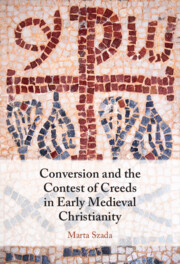Refine search
Actions for selected content:
79 results
2 - Historiographical Montage: Hasidic Popular Literature and the Making of Jewish Modernity
- from Part I - Early Hebrew Modernisms
-
-
- Book:
- A History of Modern Hebrew Literature
- Published online:
- 19 December 2025
- Print publication:
- 22 January 2026, pp 27-49
-
- Chapter
- Export citation
12 - Hagiography
- from Part III - Representing Saints
-
-
- Book:
- The Cambridge Companion to Counter-Reformation Sanctity
- Published online:
- 12 December 2025
- Print publication:
- 08 January 2026, pp 235-256
-
- Chapter
- Export citation
Huei Tlamahuiçoltica: The Hagiographic Origin of the Guadalupan Narrative and Spanish Ideals for Nahua Sanctity
-
- Journal:
- Horizons , First View
- Published online by Cambridge University Press:
- 18 November 2025, pp. 1-28
-
- Article
- Export citation
14 - Faustus of Riez, Homily on Saint Maximus, Bishop and Abbot
- from Part II - Forming and Overseeing the Community
-
-
- Book:
- The Cambridge Edition of Early Christian Writings
- Published online:
- 19 May 2025
- Print publication:
- 12 June 2025, pp 249-259
-
- Chapter
- Export citation
25 - Callinicus, The Life of Hypatius prol.–19, 23, 25–30, 32–47, 49–56
- from Part IV - Policing the Community
-
-
- Book:
- The Cambridge Edition of Early Christian Writings
- Published online:
- 19 May 2025
- Print publication:
- 12 June 2025, pp 497-546
-
- Chapter
- Export citation
12 - Hilary of Arles, Sermon on the Life of Saint Honoratus
- from Part II - Forming and Overseeing the Community
-
-
- Book:
- The Cambridge Edition of Early Christian Writings
- Published online:
- 19 May 2025
- Print publication:
- 12 June 2025, pp 199-229
-
- Chapter
- Export citation
4.1 - The Saint
- from History 4 - Heroes
-
-
- Book:
- The New Cambridge History of Russian Literature
- Published online:
- 31 December 2024
- Print publication:
- 12 December 2024, pp 683-698
-
- Chapter
- Export citation
3.1 - Forms before Genres
- from History 3 - Forms
-
-
- Book:
- The New Cambridge History of Russian Literature
- Published online:
- 31 December 2024
- Print publication:
- 12 December 2024, pp 465-481
-
- Chapter
- Export citation
1 - History and Its Historians
-
- Book:
- Merovingian Worlds
- Published online:
- 22 November 2024
- Print publication:
- 05 December 2024, pp 29-62
-
- Chapter
- Export citation
Conclusion
-
- Book:
- Conversion and the Contest of Creeds in Early Medieval Christianity
- Published online:
- 06 June 2024
- Print publication:
- 13 June 2024, pp 284-294
-
- Chapter
- Export citation

Conversion and the Contest of Creeds in Early Medieval Christianity
-
- Published online:
- 06 June 2024
- Print publication:
- 13 June 2024
5 - The Portrayal of the Great Lady in the Maẓhar al-ʿajāʾib
-
- Book:
- Female Religiosity in Central Asia
- Published online:
- 25 April 2024
- Print publication:
- 02 May 2024, pp 92-115
-
- Chapter
- Export citation
6 - Meanderings
-
- Book:
- Medieval Riverscapes
- Published online:
- 15 March 2024
- Print publication:
- 28 March 2024, pp 210-239
-
- Chapter
- Export citation
15 - Saints’ Lives
- from Part IV - The New Christian World
-
-
- Book:
- The Cambridge History of Old Norse-Icelandic Literature
- Published online:
- 08 February 2024
- Print publication:
- 29 February 2024, pp 313-333
-
- Chapter
- Export citation
II.13 - Two Twelfth-Century Lives of St Frideswide
- from Twelfth Century
-
- Book:
- The Cambridge Anthology of British Medieval Latin
- Published online:
- 11 January 2024
- Print publication:
- 01 February 2024, pp 142-149
-
- Chapter
- Export citation
I.11 - Two Lives of St Cuthbert
- from Eighth Century
-
- Book:
- The Cambridge Anthology of British Medieval Latin
- Published online:
- 11 January 2024
- Print publication:
- 01 February 2024, pp 132-145
-
- Chapter
- Export citation
Marriage, comedy, and the patristic tradition in the first Ptochoprodromic poem
-
- Journal:
- Byzantine and Modern Greek Studies / Volume 48 / Issue 2 / October 2024
- Published online by Cambridge University Press:
- 18 January 2024, pp. 253-268
- Print publication:
- October 2024
-
- Article
-
- You have access
- Open access
- HTML
- Export citation
GOSCELIN OF SAINT-BERTIN’S MATINS LESSONS FOR THE ABBESS-SAINTS OF BARKING ABBEY IN LONDON, BRITISH LIBRARY, COTTON MS OTHO A XII
-
- Article
-
- You have access
- Open access
- HTML
- Export citation
4 - Narrative Fragments
- from Part III - Relics and the Horizons of Musical Representation
-
- Book:
- Music and the Making of Medieval Venice
- Published online:
- 12 October 2023
- Print publication:
- 26 October 2023, pp 119-155
-
- Chapter
- Export citation
